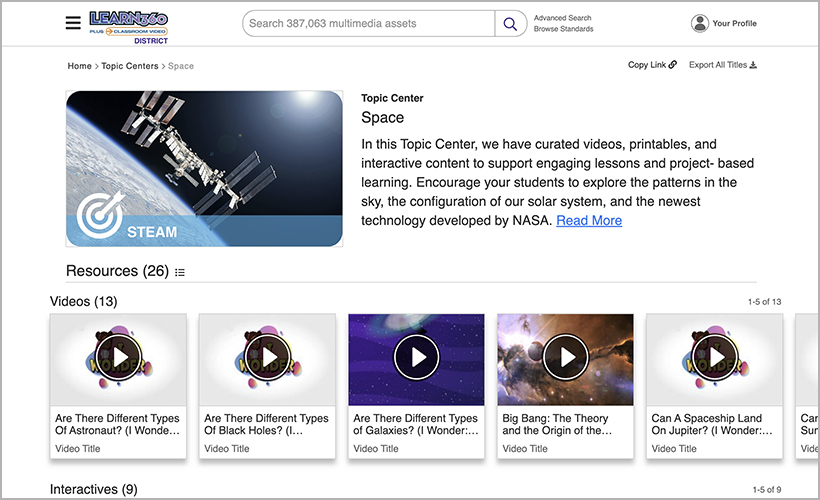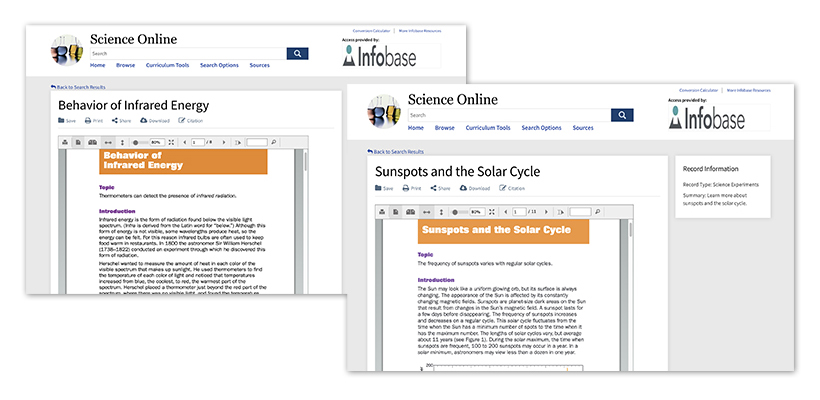“Tranquility Base, here. The Eagle has landed.”
On July 20, 1969, the first crewed mission to the moon landed in the moon’s Sea of Tranquility. In the United States, we commemorate that landing every July 20 with Space Exploration Day, a day to remember this historic mission and to encourage young people to pursue careers in space exploration and science.
Infobase has many products with amazing science content that can inform, educate, and entertain students of all ages and backgrounds—a key part of ensuring they grow up to be engaged global citizens and take their own giant leaps for mankind as adults. Educators will also find tools and resources they can use to help curious students explore the “strange new worlds” of astronomy.
Learn360’s Space Topic Center
Educators, are you looking for content to help with planning lessons and assignments, and need it quickly? Learn360 has just what you need with its newest feature. Topic Centers bring together specially selected, ready-to-use content on curricular and popular topics—including space! In Learn360’s Space Topic Center, you can find videos, interactives, and printables that can encourage your students to explore patterns in the sky, the configuration of our solar system, the newest technology developed by NASA, and other important, interesting, and fun topics on space.

Here is just some of the content you can find in Learn360’s Space Topic Center:
- Are There Different Types of Black Holes? (I Wonder: Space series) (video)
- Big Bang: The Theory and the Origin of the Universe (video)
- Gravity on Earth and Space (video)
- Not Boring Jeopardy—Space Edition (game)
- Spacequake (game)
- Moon Phases Project (printable)
- Solar Energy (printable)
- And much more!
Explore Space and Astronomy Topics with Science Online
Science Online features 11 Topic Centers that bring together a wealth of content on core science disciplines to help students find a starting point for their research, including a comprehensive Space and Astronomy Topic Center where you’ll find:
- Editor-selected overview articles on astronomy, cosmology, rocketry, and other topics
- Suggested keyword searches
- Key videos and animations
- Printable experiments on topics such as “Behavior of Infrared Energy,” “Sunspots and the Solar Cycle,” and others
- Thoughtful, clear diagrams illustrating subjects such as exoplanets, food in space, and gamma ray astronomy
- Key tables and data on asteroids, brightest stars, and much more
- A comprehensive Space and Astronomy timeline highlighting major events in this area of science from 3500 BCE to today.

Science Online also includes biographical articles on notable people in science—including astronomers, mathematicians, and astronauts as well as women and multicultural scientists—all easily accessible via the Featured People slider on the home page. Learn about Stephen Hawking, Mae Carol Jemison, Katherine G. Johnson, Ellen Ochoa, Sally Ride, Annie Jump Cannon, and more. Which story will inspire YOUR students to become the next great space explorers?
Hear Scientists Tell Their Stories with Today’s Science
Got middle and high school students who are seriously thinking about a career in space science? Direct budding astronomers and potential future astronauts toward Today’s Science, the database that helps students think like scientists by bridging the gap between the science taught in class and real-world discoveries.
Students can find thousands of original articles on astronomy and space, grouped by topics such as Cosmic Blasts and Extraterrestrial Life and written in easy-to-understand language. Plus, Today’s Science features the unique “Conversations with Scientists”—a collection of more than 800 engaging and insightful Q&As with today’s leading scientists across virtually every field of science, including the space sciences. These interviews explore the how and why of the scientists’ research as well as their perspective of the latest developments in their field and the career paths that they followed to achieve their goals.
Here are just some of the astronomy and space-related Conversations with Scientists you can find in Today’s Science:
- Layers of Mars, with Ling Chen, professor of geophysics at the Institute of Geology and Geophysics, Chinese Academy of Sciences
- Observing the Moon, with Casey I. Honniball, NASA Postdoctoral Program (NPP) Fellow at the Goddard Space Flight Center in Prince Edward’s County, Maryland
- Tackling What Lies Beneath, with Jim Fuller, assistant professor of theoretical astrophysics at the California Institute of Technology (Caltech) in Pasadena
- Modeling Supersonic Flow, with Robert Georges, professor in the department of molecular physics at the University of Rennes’ Institute of Physics in France
- Exploring Space, with Paul O. Hayne, assistant professor of astrophysical and planetary sciences at the University of Colorado, Boulder and a member of the Laboratory for Atmospheric and Space Physics
- Examining an Asteroid, with Ryuji Okazaki, associate professor in the Department of Physics, Faculty of Science and Technology, at the Tokyo University of Science
Looking for a Career in Space? Check Out Ferguson’s Career Guidance Center
Students who are set on a career in the space sciences will not only need to decide what career they want and what job options they have, but they’ll also need to learn about the nuts and bolts of how to get there: What degrees and skills will they need? What’s the average salary? What level of experience do employers expect?
Ferguson’s Career Guidance Center has just what they need. Ferguson’s features expertly researched, detailed content on more than 150 industries—including Aerospace, Space Exploration, and other areas of STEM—and more than 1,200 professions. Industry and professions profiles bring together a wealth of content, including current information on earnings, employment trends, job requirements, and essential skills using data from trustworthy sources such as the Bureau of Labor Statistics, professional associations and unions, industry reports, and working professionals. Professions articles cover new and emerging careers in space exploration, such as Aerospace Medicine Physicians, Hypersonic Engineers, Space Lawyers, Space Pilots, Space Tourism Managers, and more.
With each industry profile, students will find a detailed overview of the industry as well as its background, structure, outlook, resources and associations, links to related professions, and more. Profession articles feature links to information about the profession’s history, earnings, work environment, education and training requirements, certification and licensing requirements, experience, advancement prospects, and outlook, plus a “Find a Job” link that will take them to current, live job listings for that profession. Ferguson’s also includes Career Q&A: Professional Advice and Insight videos that let users get a no-nonsense insider’s perspective from working professionals across multiple industries, including Aerospace Engineer and Astrophysicist.
Want more? Ferguson’s Career Guidance Center can also help students search for schools, prepare a résumé, seek an apprenticeship or internship, build much-needed workplace skills, and so much more. Ferguson’s directory of internships includes programs at Boeing, Lockheed-Martin, NASA, the Smithsonian, SpaceX, and more. Even if they aren’t searching for careers in STEM, your students’ career search starts here.
Contact us today to learn which solutions are right for your students. Or test drive any or all of these resources with a FREE TRIAL.
See also:
- We’ve partnered with Abbott to showcase its groundbreaking podcast series, Shaping the Future of STEM. Listen to the six-part podcast here to learn about the important roles women are playing in changing the face of STEM.
- FREE infographic: Inspiring Women of Science & Technology: Yesterday and Today
- Make the Most of Learn360’s New Topic Centers
- Learn About Multicultural Scientists with Science Online
- Today’s Science Brings Home the Platinum!
- New Apprenticeships and More Come to Ferguson’s Career Guidance Center



